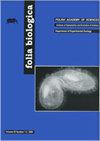mcpa除草剂配方对鲤鱼血液学、生化和组织学的影响
IF 0.8
4区 生物学
Q4 BIOLOGY
引用次数: 0
摘要
除草剂(杂草控制剂)在农作物中被大量使用。MCPA(2-甲基-4-氯酚氧乙酸)是一种用于控制谷物和其他作物杂草的除草剂。本研究的目的是研究一种基于mcpa的除草剂制剂(Chwastox Extra®300 SL)对鲤鱼的毒性作用。这些鱼被暴露在相当于1毫克/升或5毫克/升MCPA浓度的环境中10天。我们的分析显示血液学参数在治疗期间的波动。暴露1 d后血浆生化变化有统计学意义,即总蛋白浓度和丙氨酸转氨酶活性下降。鳃、躯干、肾脏和肝脏未见组织病理学病变。本研究结果表明,Chwastox Extra®300 SL对鲤鱼具有较低的毒性。血液指标对除草剂制剂的敏感性高于所选器官的显微结构。建议进一步研究Chwastox对水生无脊椎动物和其他类群鱼类的影响。本文章由计算机程序翻译,如有差异,请以英文原文为准。
Effects of an MCPA-based herbicide formulation on the common carp Cyprinus carpio Linnaeus, 1758 – haematological, biochemical and histological evaluation
Herbicides (weed control agents) are used in crops on a massive scale. MCPA (2-methyl-4-chlorophen- oxyacetic acid) is a herbicide used to control weeds in cereals and other crops. The aim of this study was to investigate the toxic effects of an MCPA-based herbicide formulation (Chwastox Extra ® 300 SL) in the common carp ( Cyprinus carpio ). The fish were exposed for 10 days, to a concentration which corresponded to 1 mg/l or 5 mg/l of MCPA. Our analysis showed fluctuations of the haematological parameters during the treatment. Plasma biochemical changes that were statistically significant, i.e.a decrease of the total protein concentration and alanine aminotransferase activity, were observed after 1 day of exposure. No histopathological lesions in the gills, trunk kidney and liver were identified. The results of the present study indicate that Chwastox Extra ® 300 SL has a relatively low toxicity for the common carp. It was also observed that the blood indices were more sensitive to the tested herbicide formulation than the microstructure of the selected organs. Further research aimed at studying the effects of Chwastox on water invertebrates and fish of other taxa is recommended.
求助全文
通过发布文献求助,成功后即可免费获取论文全文。
去求助
来源期刊

Folia Biologica-Krakow
医学-生物学
CiteScore
1.10
自引率
14.30%
发文量
15
审稿时长
>12 weeks
期刊介绍:
Folia Biologica (Kraków) is an international online open access journal accepting original scientific articles on various aspects of zoology: phylogeny, genetics, chromosomal studies, ecology, biogeography, experimental zoology and ultrastructural studies. The language of publication is English, articles are assembled in four issues per year.
 求助内容:
求助内容: 应助结果提醒方式:
应助结果提醒方式:


